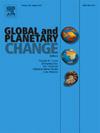The temperature-precipitation duel and tropical greening during the Early Eocene Greenhouse episode
IF 4
1区 地球科学
Q1 GEOGRAPHY, PHYSICAL
引用次数: 0
Abstract
Under rising anthropogenic CO2, the future of the tropical climate states and the response of the biosphere, specifically the fate of the tropical rainforest (TRF), is uncertain. Therefore, deep-time climate proxy records and model simulations are being extensively utilized to understand the possible response of the TRF community during extreme climate states. However, comprehensive climate-TRF proxy data from the tropical/equatorial region for the paleo-global warming episodes, e.g., Late Paleocene – Early Eocene interval (∼56 to 51 Ma, encompassing transient hyperthermal events like Paleocene-Eocene Thermal Maximum [PETM], Eocene Thermal Maximum2 [ETM2]/H1/ Eocene Layer of Mysterious Origin [ELMO], H2, I1, and I2), are very limited and create difficulties in the validation of simulated results. Here we present long-term land surface temperature and precipitation (δ2H and δ18O of pedogenic clay mineral-derived) and TRF diversity (palynology) data from a paleo-equatorial region, spanning the ∼56 to 51 Ma interval. Present data suggest that the hydrological response to global warming was not temporally uniform in the paleo-equatorial land. While a significantly increased rainfall buffered the terrestrial temperature during the PETM, an insignificant increase in precipitation and negligible temperature lowering can be observed during the ETM2 hyperthermal event. However, the climate system's response during the other Early Eocene hyperthermals, i.e., H2, I1, and I2, was very similar to the PETM. Despite these small aberrations, the long-term average equatorial land surface temperature (27 ± 4 °C) during the Early Eocene greenhouse episode remained very similar to the modern equatorial temperature (28–30 °C). Rainfall proxy and plant diversity data suggest that the precipitation aided TRFs' resilience and proliferation, possibly through temperature buffering, during this paleo-greenhouse episode.
早始新世温室事件期间的温度-降水对决与热带绿化
在人为二氧化碳增加的情况下,热带气候状态的未来和生物圈的反应,特别是热带雨林(TRF)的命运,是不确定的。因此,人们广泛利用深时气候代用记录和模型模拟来了解热带雨林群落在极端气候状态下可能做出的反应。然而,热带/赤道地区在古全球变暖时期(如晚古新世-早古新世)的气候-TRF 代用数据并不全面、晚古新世-早始新世区间(∼56 至 51 Ma,包括瞬时高热事件,如古新世-始新世热极值 [PETM]、始新世热极值2 [ETM2]/H1/ 始新世神秘起源层 [ELMO]、H2、I1 和 I2)的数据非常有限,给模拟结果的验证带来了困难。在此,我们提供了来自一个古赤道地区的长期地表温度和降水(源于成土粘土矿物的δ2H 和 δ18O)以及 TRF 多样性(古生物学)数据,时间跨度为 ∼56 至 51 Ma。目前的数据表明,古赤道地区对全球变暖的水文响应在时间上并不一致。在 PETM 期间,降水量的大幅增加对陆地温度起到了缓冲作用,而在 ETM2 高热事件期间,降水量的增加并不明显,温度的降低可以忽略不计。然而,气候系统在其他早始新世高热事件(即 H2、I1 和 I2)期间的反应与 PETM 非常相似。尽管存在这些小的偏差,早始新世温室效应期间赤道陆地表面的长期平均温度(27 ± 4 °C)仍然与现代赤道温度(28-30 °C)非常相似。降雨代用数据和植物多样性数据表明,在这一古温室事件中,降水可能通过温度缓冲作用帮助了TRFs的恢复和扩散。
本文章由计算机程序翻译,如有差异,请以英文原文为准。
求助全文
约1分钟内获得全文
求助全文
来源期刊

Global and Planetary Change
地学天文-地球科学综合
CiteScore
7.40
自引率
10.30%
发文量
226
审稿时长
63 days
期刊介绍:
The objective of the journal Global and Planetary Change is to provide a multi-disciplinary overview of the processes taking place in the Earth System and involved in planetary change over time. The journal focuses on records of the past and current state of the earth system, and future scenarios , and their link to global environmental change. Regional or process-oriented studies are welcome if they discuss global implications. Topics include, but are not limited to, changes in the dynamics and composition of the atmosphere, oceans and cryosphere, as well as climate change, sea level variation, observations/modelling of Earth processes from deep to (near-)surface and their coupling, global ecology, biogeography and the resilience/thresholds in ecosystems.
Key criteria for the consideration of manuscripts are (a) the relevance for the global scientific community and/or (b) the wider implications for global scale problems, preferably combined with (c) having a significance beyond a single discipline. A clear focus on key processes associated with planetary scale change is strongly encouraged.
Manuscripts can be submitted as either research contributions or as a review article. Every effort should be made towards the presentation of research outcomes in an understandable way for a broad readership.
 求助内容:
求助内容: 应助结果提醒方式:
应助结果提醒方式:


